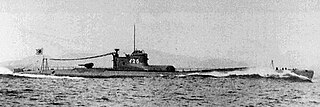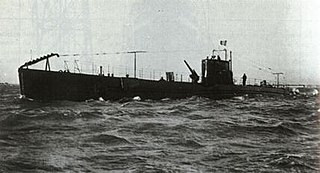
The R-class or Romolo-class submarine was a group of submarines built for the Royal Italian Navy during World War II. They were designed as blockade running transport submarines for transporting high-value cargo from Europe to Japan and vice versa. Axis-occupied Europe lacked strategic materials such as tungsten, tin and some commodities such as rubber.
The Japanese submarine I-28 was one of 20 Type B cruiser submarines of the B1 sub-class built for the Imperial Japanese Navy (IJN) during the 1940s.

The Japanese submarine I-31 was one of 20 Type B cruiser submarines of the B1 sub-class built for the Imperial Japanese Navy (IJN) during the 1940s.

Submarine No.71 was an experimental high-speed submarine built for the Japanese Imperial Navy (IJN) during the 1930s.
Comandante Faà di Bruno, also referred to by its shortened name Faà di Bruno, was a Marcello-class submarine built for the Royal Italian Navy in the 1930s. It was sunk in 1940 by British and Canadian destroyers escorting a convoy.
The Italian submarine Acciaio was the name ship of her class of submarines built for the Royal Italian Navy during World War II.
The Italian submarine Flutto was the name ship of her class of submarines built for the Royal Italian Navy during World War II. She obtained no successes during her short career, and was sunk by British ships during the Invasion of Sicily in 1943.
Pietro Calvi was the lead ship of its class of two submarines built for the Regia Marina during the 1930s. Completed in 1936, she played a minor role in the Spanish Civil War of 1936–1939 supporting the Spanish Nationalists. The submarine made multiple patrols in the Atlantic Ocean during the Second World War, sinking seven Allied ships. Pietro Calvi was rammed and sunk by a British convoy escort in July 1942.

The Argonauta-class submarine was the first sub-class of the 600 Series of coastal submarines built for the Regia Marina during the 1930s. Some of these boats played a minor role in the Spanish Civil War of 1936–1939 supporting the Spanish Nationalists. Of the seven boats built in this class, only a single one survived the Second World War.
Argo was the lead ship of her class of two submarines ordered by the Portuguese government, but taken over and completed for the Regia Marina during the 1930s.
Velella was one of a pair of submarines ordered by the Portuguese government, but taken over and completed for the Regia Marina during the 1930s.
Anfitrite was one of a dozen Sirena-class submarines, the second sub-class of the 600 Series of coastal submarines built for the Regia Marina during the early 1930s.
Naiade was one of a dozen Sirena-class submarines, the second sub-class of the 600 Series of coastal submarines built for the Regia Marina during the early 1930s.
Ondina was one of a dozen Sirena-class submarines, the second sub-class of the 600 Series of coastal submarines built for the Regia Marina during the early 1930s.
Rubino was one of a dozen Sirena-class submarines, the second sub-class of the 600 Series of coastal submarines built for the Regia Marina during the early 1930s.
Argonauta was the lead ship of her class of seven submarines built for the Regia Marina during the early 1930s.
Jantina was one of seven Argonauta-class submarines built for the Regia Marina during the early 1930s. She played a minor role in the Spanish Civil War of 1936–1939 supporting the Spanish Nationalists, and was later sunk during World War II.
Medusa was one of seven Argonauta-class submarines built for the Regia Marina during the early 1930s.
Serpente was one of seven Argonauta-class submarines built for the Regia Marina during the early 1930s.
The second Ro-55 was an Imperial Japanese Navy Kaichū type submarine of the K6 sub-class. Completed and commissioned in September 1944, she served in World War II and was sunk during her first war patrol in February 1945.



